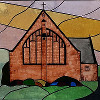And a sword will pierce your own soul too (Luke 2:35)
This year’s Lent Course by the Diocese of Edinburgh is entitled “Lent: a season of Pilgrimage”. It invites us to turn to sacred time and space and deepen our walk with God, with each other and with ourselves.
The pilgrimage route of Santiago de Compostela was one of the most significant pilgrimage routes of medieval times. It still exists as a web of journeys leading across Europe. You may have walked part of it. There are many points of origin, but one goal; the shrine of St James the Apostle in northern Spain. In the villages along the Way of St James, there stands at many of the village squares large stone crucifixes where pilgrims can pray and mark yet another stage of their journey. Especially in the province of Galicia, where Santiago lies, these crucifixes are unique. Made of stone and standing some five metres high, they have Jesus at his death on one face, and Mary in her own agony on the opposite face. He is nailed to one side, dying; she stands on the other side, weeping. On some of these crucifixes, an iron sword pierces Mary’s breast. Jesus’ suffering is her own. A sword pierces her own soul, as foretold in Simeon’s prophecy.
In the fifth century, Mary was given the title, theotokos, meaning God-bearer. In the Eastern Church this has often been depicted in icons down the centuries. As mother of Jesus, she bears the Son of God into the world. As such, she indicates to each of us our common vocation: to bear Jesus into the world. To nurture Jesus. To show him to others, the way a mother proudly shows off her child.
In her Lenten book entitled “I am with you”, the American priest and theologian, Kathryn Greene McCreight writes that “Jesus is a living person. He is not just a generic human reality separate from his own specific identity. Mary is one of the only two personal locators (ie someone who connects a reader directly to a story) in the creeds who pinpoint Jesus’ non-mythic presence. The other such person is Pontius Pilate. Mary bears the Christ. Pilate murders him. We each are meant to be God-bearers”.
On this “Laetare” Sunday (otherwise known as “Refreshment Sunday”) traditionally being a day of celebration during the austerity of Lent, with the delights of rose pink vestments and altar frontals, our gospel reading with only three verses is direct. Despite the surprise at what Simeon had told them Jesus’ parents must also have been dismayed by those unexpected words which summarise the work and fate of Jesus:-
“This child is destined for the falling and rising of many in Israel, and to be a sign that will be opposed so that the inner thoughts of many will be revealed – and a sword will pierce your own soul too”.
We are not told in the gospels when Joseph died. We do know that Jesus’ mother, Mary, was with him as she watched him die. Sometimes I listen to the haunting Stabat Mater, depicting this scene, composed by Giovanni Pergolesi (1710-1736) during his final illness. It still sends shivers down my spine.
As we continue our pilgrimage through Lent, may we know God’s presence, whether in times of blessing or sadness, and seek some consolation and comfort from Mary, Mother of God.
Jesus, Eternal Word of the Father,
You shared our humanity.
May we so live in your love
That we come to share in your divinity.
